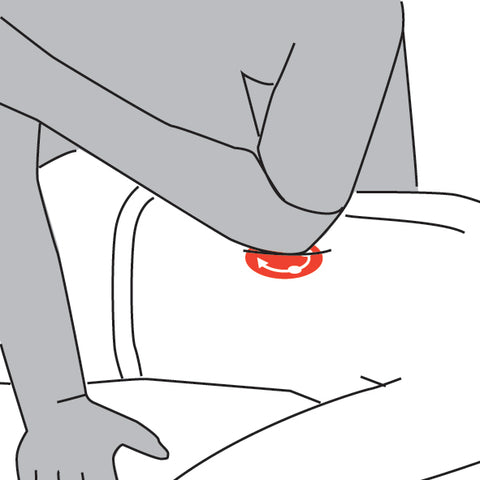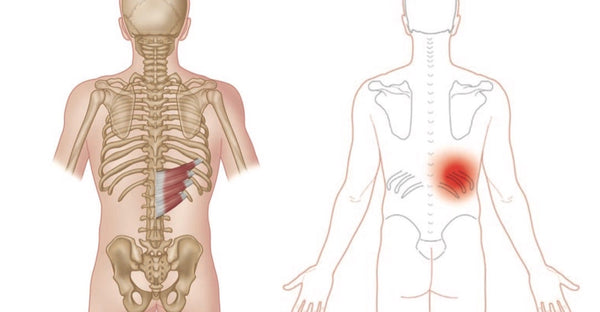Trigger Point Treatment - Serratus Posterior Inferior

Serratus Posterior Inferior Muscle
Serratus Posterior Inferior is an often overlooked cause of lower back pain
This muscle may be primarily a muscle of proprioception but it's important to remember that it also acts as a supporting structure for the lower back, stabilizing the four lower ribs and assisting in pulling them down and back.
The importance of the serratus posterior inferior is often forgotten and tightness and trigger points tend to be overlooked.
Kinetics
The serratus posterior inferior works in conjunction with the iloicostalis, longissimus thoracis, and quadratus lumborum.
It may also work with the serratus posterior superior as a spinal stretch receptor system or kinesiological monitor (Vilensky et al. 2001).

Serratus Posterior Inferior - trigger points and tightness in this muscle tend to be overlooked
Trigger Points
Trigger points in the serratus posterior inferior may cause an uncommon local ache radiating over and around the muscle.
This may extend across the back and over the lower ribs, even continuing through the chest to the front of the body.
This discomfort is typically described by clients as a nagging ache.
In many cases this pain will remains after other trigger points have been inactivated.
This should be a good indicator for the therapist to recheck the serratus posterior inferior for undiscovered trigger points.

Trigger points in serratus posterior inferior may cause an uncommon local ache radiating over and around the muscle
Indicators and Perpetuating Factors
These Trigger points are usually initiated by acute back strain in conjunction with the strain of other muscles in the region.
Perpetuating factors include paradoxical breathing, sagging and unsupportive mattresses (e.g. sleeping on a sofa or water bed), chairs with insufficient lumbar support, body asymmetry, and herpes zoster infections.
General Advice for Patients
Control perpetuating factors: Have the trigger points addressed by a therapist. The use of pressure tools such as the Backnobber are terrific for myofascial release self-help. Stretching and muscle energy techniques (see below).
Stretching
Cross your forearms just above the wrist, at about chest height.
Inhale deeply as you slowly raise them up until the area where the arms cross is level with your forehead.
Now lower the arms as you exhale.
Do this once or twice, allowing for a brief rest (a few breaths) before repeating. Do this exercise set several times a day.
Massage and Soft Tissue Treatments
Massage and soft tissue treatments can be beneficial in relieving tension and promoting relaxation in the serratus posterior inferior muscle. Here's how to effectively massage and apply soft tissue treatments to this area:
-
Warm-Up: Before starting the massage or soft tissue treatment, it's essential to warm up the muscles and surrounding tissues. This can be done through light movements, gentle stretching, or applying heat packs to the area.
-
Positioning: Position the client comfortably, either lying face down on a massage table or seated with their back exposed and supported.
-
Palpation: Begin by palpating the area around the lower thoracic vertebrae and lower ribs to locate the serratus posterior inferior muscle. Use your fingertips to feel for any areas of tenderness, tension, or trigger points.
-
Massage Techniques:
- Effleurage: Start with gentle effleurage strokes along the length of the muscle to warm up the tissues and promote circulation.
- Petrissage: Use kneading and squeezing motions to target deeper layers of muscle tissue and release tension.
- Stripping: Apply firm pressure along the length of the muscle using your thumbs or fingertips, moving from the origin to the insertion point.
- Trigger Point Release: Locate any tender or tight spots within the muscle and apply sustained pressure or ischemic compression to release trigger points.
-
Stretching: After massaging the serratus posterior inferior, incorporate stretching techniques to further release tension and improve flexibility. Gently encourage the client to reach their arms overhead or perform lateral bending movements to stretch the muscle.
-
Soft Tissue Mobilization: If necessary, utilize soft tissue mobilization techniques such as myofascial release or instrument-assisted soft tissue mobilization (IASTM) to address adhesions or scar tissue within the muscle.
-
Feedback: Throughout the massage or soft tissue treatment, communicate with the client to ensure their comfort and adjust the pressure or technique as needed. Encourage deep breathing to enhance relaxation and facilitate release in the muscle.
-
Post-Treatment Care: After the massage or soft tissue treatment, advise the client to drink plenty of water to flush out toxins released during the session. Recommend gentle stretching exercises or self-care techniques to maintain the benefits of the treatment between sessions.
By incorporating massage and soft tissue treatments for the serratus posterior inferior muscle into your practice, you can help alleviate discomfort, improve mobility, and enhance overall well-being for your clients. As always, it's essential to customize your approach based on individual needs and preferences, and to seek appropriate training and certification in manual therapy techniques.
About Niel Asher Education
Niel Asher Education (NAT Global Campus) is a globally recognised provider of high-quality professional learning for hands-on health and movement practitioners. Through an extensive catalogue of expert-led online courses, NAT delivers continuing education for massage therapists, supporting both newly qualified and highly experienced professionals with practical, clinically relevant training designed for real-world practice.
Beyond massage therapy, Niel Asher Education offers comprehensive continuing education for physical therapists, continuing education for athletic trainers, continuing education for chiropractors, and continuing education for rehabilitation professionals working across a wide range of clinical, sports, and wellness environments. Courses span manual therapy, movement, rehabilitation, pain management, integrative therapies, and practitioner self-care, with content presented by respected educators and clinicians from around the world.
Known for its high production values and practitioner-focused approach, Niel Asher Education emphasises clarity, practical application, and professional integrity. Its online learning model allows practitioners to study at their own pace while earning recognised certificates and maintaining ongoing professional development requirements, making continuing education accessible regardless of location or schedule.
Through partnerships with leading educational platforms and organisations worldwide, Niel Asher Education continues to expand access to trusted, high-quality continuing education for massage therapists, continuing education for physical therapists, continuing education for athletic trainers, continuing education for chiropractors, and continuing education for rehabilitation professionals, supporting lifelong learning and professional excellence across the global therapy community.

Continuing Professional Education
Looking for Massage Therapy CEUs, PT and ATC continuing education, chiropractic CE, or advanced manual therapy training? Explore our evidence-based online courses designed for hands-on professionals.


















